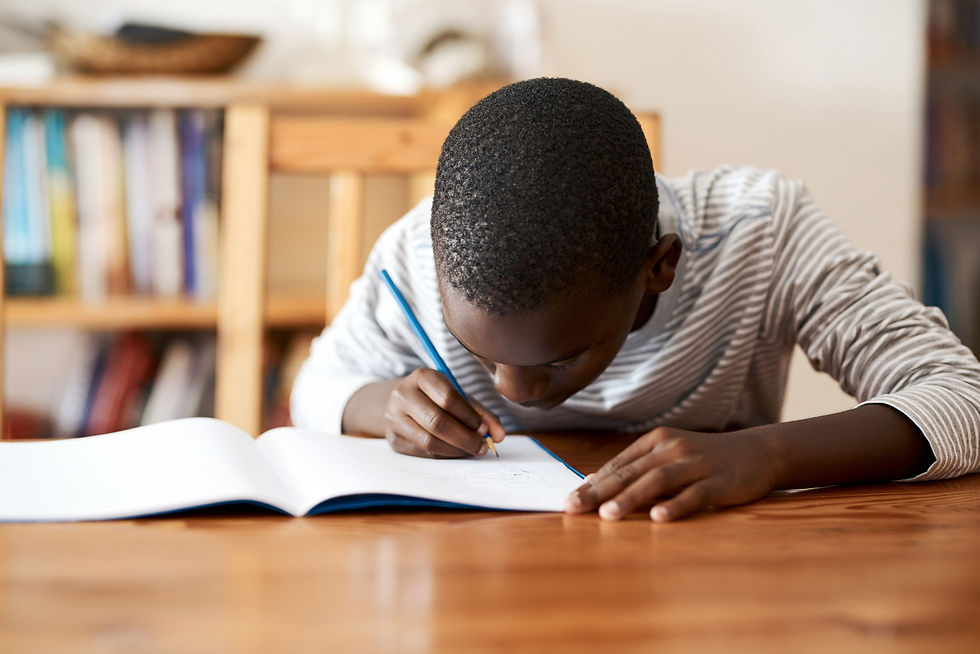Boosting Visual Processing Skills at Home: Activities for Enhancing Your Child's Visual Sensory System
- Susan Donohoe
- Jun 22, 2020
- 6 min read
Updated: Mar 31
Have you ever stopped to think about how incredible our visual sensory system is? It's a super-efficient machine that lets us see and understand the world around us in stunning detail. But what happens when this system gets a little glitchy? Well, it turns out that visual sensory disorders can throw a major wrench in the works, especially when it comes to learning.
Studies show that about 80% of what kids learn comes through visual processing. That means when issues like refractive errors or more serious conditions like amblyopia mess with a child's ability to process visual information, it can really impact their learning abilities. But here's the good news: there are ways to help!
By tailoring play and learning environments to support visual processing, we can make a world of difference for kids with visual sensory disorders. Think multisensory activities, specialized tools, and clever strategies to boost visual attention and tracking skills. In this article, we're diving deep into how these disorders affect learning, and we'll explore some practical tips for creating inclusive spaces where every child can thrive.
So, whether you're a parent, teacher, or just someone who cares about leveling the playing field for all kids, stick around. Because with a little knowledge and some creative thinking, we can help children with visual sensory disorders reach their full potential, both in and out of the classroom.
How Do Visual Sensory Systems Help Us Learn?
Simply put, the visual sensory system is responsible for processing what we see. It starts with light entering the eyes, triggering a signal to the brain's primary visual cortex. This signal is then converted into the images we perceive. The system doesn't include issues like nearsightedness or farsightedness, which affect vision but not processing. If there's a suspicion of sensory issues, eyesight must be evaluated first.
This system handles visual processing, perception, eye movements, and aspects like color and shape. It's crucial for learning, so disorders can lead to school and language difficulties. It's essential to address vision problems separately, as they can hinder information interpretation.

Understanding the visual system's role in learning highlights its importance. Occupational therapists trained in school settings can aid children in improving visual integration and learning across all activities. By addressing visual sensory disorders, we can help children thrive academically and beyond.
Better Understand Visual Processing By Unraveling the 8 Subtypes
Visual Discrimination Disorder
Struggle to differentiate similar-looking objects or symbols, leading to difficulties in reading, writing, and recognizing details in everyday tasks due to confusion or misinterpretation.
Visual Memory Disorder (long and short term)
Visual Motor Processing Disorder
Visual Sequential Memory Disorder
Visual Spatial Processing Disorder
Visual Figure Ground Disorder
Visual Form Constancy Disorder
Visual Closure Disorder
What Are Common Visual Processing Issues in School-Aged Children?
Difficulty copying from a white board
Nausea when trying to read in the car
Poor math skills
May complain of tired or hurting eyes
Tires easily, or could be fidgety
Difficulty with sports, gym class, etc.
Difficulty memorizing spelling, what they have read or what they have seen
Work performance is sloppy, child seems disorganized
Difficulty with eye-hand coordination activities in school or play
Reverses letter writing often when not developmentally expected, such as writing d instead of b, and/or reads words out of order
Difficulty finding objects in a busy background such as I spy or in the refrigerator, difficulty with puzzles, or trouble extracting certain information from a printed page
Difficulty reading and comprehending despite average or above average verbal comprehension
Unable to judge distances accurately, this can be displayed as bumping into things easily or trouble pouring liquids
Difficulty with fine motor skills such as cutting, art work, tracing, etc.
What Role Do Hyposensitivity and Hypersensitivity Play In Learning Disabilities?
Hyposensitivity and hypersensitivity are vital aspects to consider when addressing learning disabilities in children. Hypersensitive kids may avoid bright lights, eye contact, and struggle with headaches or nausea during certain activities. They might also experience increased anxiety, avoid group play, and find crowded spaces challenging. Meanwhile, hyposensitive children may also seem easily distracted by bright colors and engaging images, and they might engage in excessive movements while reading or doing tasks.
These sensory differences significantly impact learning, affecting focus, attention, and participation in various activities. When left unaddressed, they can lead to academic setbacks. Recognizing and addressing these sensory needs is crucial for creating supportive learning environments that cater to individual differences and promote academic success. By collaborating with educators, caregivers, and professionals, we can implement tailored interventions that help children overcome these sensory challenges and thrive in school.

Hypersensitive
Aversion to bright lights or certain colors
Avoiding eye contact
Headaches, nausea after reading, watching TV, or computer activities
Covering eyes
Bumps into things, people, or trips while walking
Increased anxiety or emotional behaviors
Avoids group play activities
Avoids crowded spaces
Hyposensitive
Stares into space, stares at objects or light
Looks unusually close at objects, or out of the side of their eyes
Enjoys bright colors and stimulating images to the point of becoming distracted
Shakes their head or engages in movement when reading or doing table tasks, thus increasing their vestibular stimulation
Constantly flicks their pencil or other objects back and forth in front of their eyes unwarranted
15 Home Activities To Improve Your Child's Visual Processing
Tracing
Tracing activities are a fun way to engage visual processing, enhancing focus and coordination.
Imitation Games
Weaving and Sewing
Lego Building
Scavenger Hunt Art Activities
Puzzles
Balance Beam
Origami
I Spy
Badminton
Following Cooking Instructions
Blowing Bubbles
Obstacle Course
Whisper Down The Lane
Kick Ball
Visual Processing Activities Can Empower A Child's Learning Process
Providing tailored home activities is key to boosting the learning abilities of kids with visual processing disorders.
From tracing and puzzles to kickball and I Spy, there's a world of engaging options to explore. So, let's roll up our sleeves and create an environment where our little learners can thrive!
Products You May Like:
